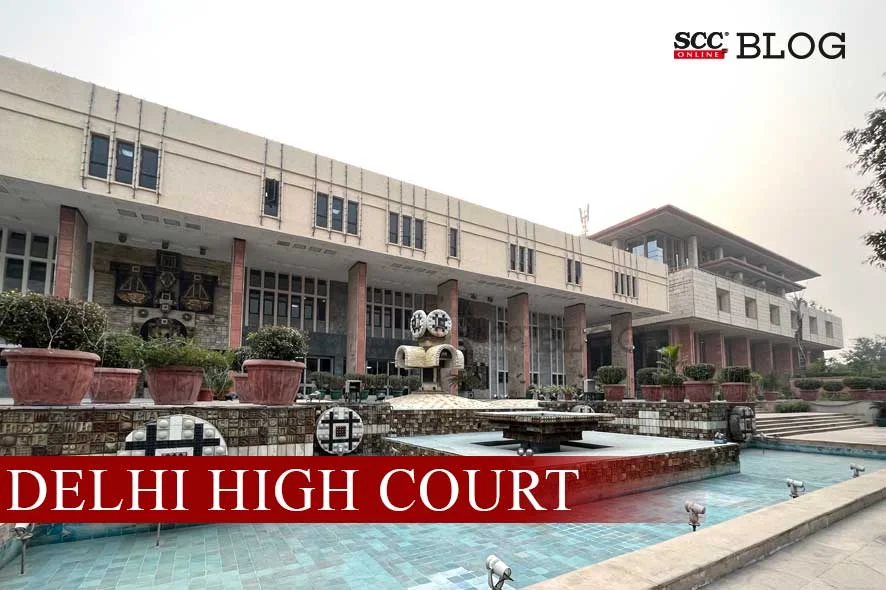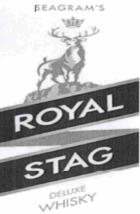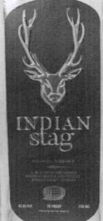Delhi High Court: In a case wherein plaintiff manufactured and sold Indian Made Foreign Liquor (‘IMFL’) under marks “ROYAL STAG” and “ROYAL STAG BARREL SELECT” in conjunction with  picture of a crowned stag and defendants also manufactured IMFL, under the mark “INDIAN STAG” and used its own
picture of a crowned stag and defendants also manufactured IMFL, under the mark “INDIAN STAG” and used its own  Stag device, C. Hari Shankar, J.*, held that prima facie, on a plain comparison between plaintiff’s and defendants’ marks, defendant had necessarily to be found to have infringed plaintiff’s mark, but no case of passing off was made out against defendant and in favour of plaintiff. Thus, the Court confirmed the ad interim order dated 25-07-2019, pending disposal of the suit.
Stag device, C. Hari Shankar, J.*, held that prima facie, on a plain comparison between plaintiff’s and defendants’ marks, defendant had necessarily to be found to have infringed plaintiff’s mark, but no case of passing off was made out against defendant and in favour of plaintiff. Thus, the Court confirmed the ad interim order dated 25-07-2019, pending disposal of the suit.
Background
Plaintiff was the proprietor of the word marks “ROYAL STAG” and “ROYAL STAG BARREL SELECT” in Class 33 for “wines, spirits and liqueurs” since 1996 and 2011 respectively, and the device mark  (the Stag device) in Class 33 for “alcoholic beverages including points, whisky, spirits and liquors” since 2015. Under the “ROYAL STAG” brand, plaintiff brewed and sold IMFL, and it had been doing so since 1995 and the Stag device featured prominently on its labels and its pack, and the distinctive features of plaintiff’s were “ROYAL STAG” label, a thick swirling ribbon
(the Stag device) in Class 33 for “alcoholic beverages including points, whisky, spirits and liquors” since 2015. Under the “ROYAL STAG” brand, plaintiff brewed and sold IMFL, and it had been doing so since 1995 and the Stag device featured prominently on its labels and its pack, and the distinctive features of plaintiff’s were “ROYAL STAG” label, a thick swirling ribbon  (‘the Swirl Ribbon device’), on which the mark ROYAL STAG was prominently printed in bold cream coloured lettering (
(‘the Swirl Ribbon device’), on which the mark ROYAL STAG was prominently printed in bold cream coloured lettering ( ), with the
), with the  Stag device above the ribbon.
Stag device above the ribbon.
Plaintiff submitted that these features were replicated on the outer carton of the pack, in which the bottle was sold. Plaintiff asserted that the word “STAG”, and the Stag Device constituted most prominent features of plaintiff’s registered ROYAL STAG mark, as well as of its label, and that, in replicating these features in its label, as well as in the mark INDIAN STAG per se, defendants had infringed plaintiff’s registered trade marks. The Court had granted ex parte ad interim injunction on 25-07-2019 which continued till date. Thus, plaintiff desired an injunction, against defendants, from using the marks INDIAN STAG, the Stag device (plaintiff’s or its own) and, in general, the use of the word “Stag” per se, as part of its mark.
|
Plaintiff’s label |
Defendants’ label |
Analysis, Law, and Decision
Deceptive Similarity
The Court observed that each of the rival marks, in the present case, was a composite mark consisting of two parts; in plaintiff’s case, ‘ROYAL’ and ‘STAG’ and, in defendants’, ‘INDIAN’ and ‘STAG’ and the second part of each of these marks was the same ‘STAG’. The Court relied on Amritdhara Pharmacy v. Satya Deo Gupta, 1962 SCC OnLine SC 13; Zydus Wellness Products Ltd. v. Cipla Health Ltd., 2023 SCC OnLine Del 3785; Amar Singh Chawal Wala v. Shree Vardhman Rice and Genl. Mills, 2009 SCC OnLine Del 1690; Kirorimal Kashiram Marketing & Agencies Pvt Ltd v. Shree Sita Chawal Udyog Mill, 2010 SCC OnLine Del 2933 (‘Kirorimal Kashiram Marketing Case’); and South India Beverages Pvt Ltd v. General Mills Marketing Inc., 2014 SCC OnLine Del 1953 and opined that it was apparent that the mark ‘INDIAN STAG’ had to be held to be deceptively similar to the mark ‘ROYAL STAG’.
The Court opined that “a stag was an animal and though liquor, consumed in excess, might evoke animalistic tendencies in the imbiber, the word STAG could not, in any manner of speaking, be regarded as descriptive of alcoholic beverages”. The Court further opined that the marks I’NDIAN ROYAL STAG’ and ‘INDIAN STAG’, have necessarily to be regarded as deceptively similar as both were used for IMFL and defendant had not been able to cite a single other mark, used for IMFL, which contained the word STAG or even used the Stag device. The Court relied on Kirorimal Kashiram Marketing Case (supra) and opined that the use of Stag device, by defendant, would exacerbate the confusion and no doubt, visually plaintiff’s stag might not look like defendant’s but that, however, could not make a difference. The Court noted that the second half of defendants’ mark was also STAG and thus opined that the use of STAG by defendants rendered the INDIAN STAG mark phonetically and structurally similar to the mark ROYAL STAG.
The Court opined that once the essential features of plaintiff’s mark were replicated in defendant’s mark, infringement, within the meaning of Section 24(2)(b) of the Trade Marks Act, 1999, had necessarily to be found to have taken place as the marks were similar; they were used for the same product, and, owing to these factors, there was a likelihood of confusion, or at the least association, in the mind of a consumer of average intelligence and imperfect recollection. Thus, the Court held that prima facie, therefore, on a plain comparison between plaintiff’s and defendants’ marks, defendant had necessarily to be found to have infringed plaintiff’s mark.
Plea of Disclaimer
The Court observed that the common part of plaintiff’s and defendants’ mark, which constituted a principal ground for alleging infringement, was “STAG” and the STAG part of plaintiff’s mark had not been disclaimed. There was, therefore, no embargo on plaintiff claiming exclusivity in respect of the STAG part of its mark and inasmuch as plaintiff was not claiming exclusivity in respect of its ROYAL part of its mark, the disclaimer of the ROYAL part of plaintiff’s mark could make no difference to the aspect of the infringement. Thus, the Court opined that the disclaimer entered in respect of ROYAL part of plaintiff’s mark, while granting registration to plaintiff’s ROYAL STAG mark could not, therefore, make any difference.
Likelihood of Confusion
The Court noted that there were several distinguishing factors which were determinative on the aspect of likelihood of confusion, firstly, plaintiff’s and defendants’ products both were IMFL. Secondly, there was no example of any other brand of IMFL which used STAG as part of its name. Thirdly, both the labels use the motif of a stag. Fourthly, both the marks cater to the same consumer segment, which was quite distinct from the consumer segment which consumed Scotch whisky. Thus, the Court opined that “the market place was occupied by just two solitary brands, ‘ROYAL STAG’ and ‘INDIAN STAG’ and reflecting the figure of a stag in each case, the possibility of likelihood of an association between the two marks, in the minds of a consumer of average intelligence and imperfect recollection, could not be ruled out”.
“STAG” being publici juris and common to the trade
The Court opined that once it was accepted that IMFL could be distinguished from foreign whiskies, “ROYAL STAG”, as the name used exclusively for IMFL, becomes ipso facto distinguishable from foreign whiskies which might be using “STAG” as part of their names and this distinction did not, however, impact the aspect of infringement, as plaintiff’s ROYAL STAG and defendants’ INDIAN STAG were both used for IMFL. Thus, the Court held that “STAG” was not, therefore, ineligible for registration as a trade mark and it was not, therefore, publici juris.
Infringement of the Stag device
The Court opined that the registration, in favour of plaintiff, of a device mark representing a stag, could not confer a monopoly, on plaintiff, of any and every stag device and on a visual comparison, the two stags could not be said to be alike, or even similar. Thus, the Court opined that defendants had not infringed the ![]() device mark of plaintiff, though the use, by defendants, of a
device mark of plaintiff, though the use, by defendants, of a  stag device might exacerbate confusion, of likelihood of association, which might arise when seen in conjunction with the similarity of the ROYAL STAG and INDIAN STAG marks, with no other STAG mark, used for IMFL, apparently being in existence.
stag device might exacerbate confusion, of likelihood of association, which might arise when seen in conjunction with the similarity of the ROYAL STAG and INDIAN STAG marks, with no other STAG mark, used for IMFL, apparently being in existence.
Passing Off
The Court opined that while, therefore, a prima facie case of infringement, by the use of the INDIAN STAG marked by defendants, of plaintiff’s ROYAL STAG mark, for IMFL, was made out, warranting interim injunction as sought, no case of passing off could be said to exist, prima facie. The Court further opined that “given the difference in the visual appearance of defendants’ and plaintiff’s labels, and the fact that defendants’ product was entirely exported, any finding of passing off would require the Court to be satisfied that, in foreign markets, consumers might mistake the defendants’ goods for the plaintiffs”. The Court held that prima facie, no case of passing off was made out against defendant and in favour of plaintiff.
Thus, the Court confirmed the ad interim order dated 25-07-2019, pending disposal of the suit.
[Pernod Ricard India (P) Ltd. v. A B Sugars Ltd., 2023 SCC OnLine Del 6966, decided on 31-10-2023]
*Judgment authored by: Justice C. Hari Shankar
Advocates who appeared in this case :
For the Plaintiff: Hemant Singh, Mamta Rani Jha, Waseem Shuaib Ahmed, Abhijeet Rastogi, Isha Arora, Advocates
For the Defendants: Rajeshwari H., Swapnil Gaur, Advocates









